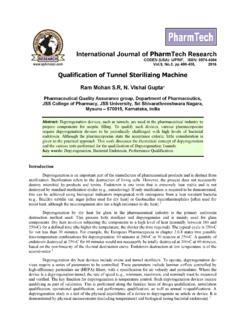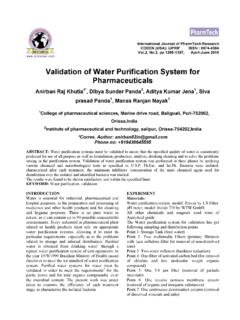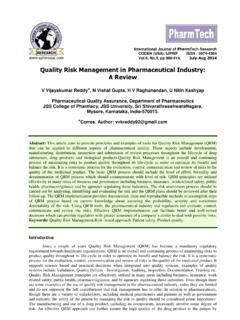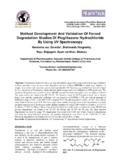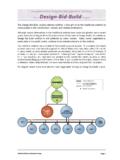Transcription of MICROSPHERES AS A NOVEL DRUG DELIVERY SYSYTEM - …
1 International Journal of ChemTech Research CODEN( USA): IJCRGG ISSN : 0974-4290 , , pp 526-534, July-Sept 2009 MICROSPHERES AS A NOVEL drug DELIVERY SYSYTEM - A *, Madhu Sudana , ,Attuluri Venkata Badarinath, and College of Pharmacy, Rajampet-516126, Andhra Pradesh State, India* Email: Tel: 91-8565-249309 mob: 91-9989530761 Abstract: MICROSPHERES are characteristically free flowing powders consisting of proteins or synthetic polymers which arebiodegradable in nature and ideally having a particle size less than 200 well designed controlled drug DELIVERY systemcan overcome some of the problems of conventional therapy and enhance the therapeutic efficacy of a given drug . There arevarious approaches in delivering a therapeutic substance to the target site in a sustained controlled release fashion.
2 One suchapproach is using MICROSPHERES as carriers for drugs. It is the reliable means to deliver the drug to the target site withspecificity, if modified, and to maintain the desired concentration at the site of interest without untoward effects. Microspheresreceived much attention not only for prolonged release, but also for targeting of anticancer drugs to the tumour. In future bycombining various other strategies, MICROSPHERES will find the central place in NOVEL drug DELIVERY , particularly in diseased cellsorting, diagnostics, gene & genetic materials, safe, targeted and effectivein vivo DELIVERY and supplements as miniatureversions of diseased organ and tissues in the : MICROSPHERES , controlled release, target site, specificity, therapeutic efficacy, NOVEL drug well designed controlled drug DELIVERY systemcan overcome some of the problems of conventionaltherapy and enhance the therapeutic efficacy of a obtain maximum therapeutic efficacy, itbecomes necessary to deliver the agent to the targettissue in the optimal amount in the right period of timethere by causing little toxicity and minimal are various approaches in delivering atherapeutic substance to the target site in a sustainedcontrolled release such approach is usingmicrospheres as carriers for are characteristically free flowingpowders consisting of protiens or synthetic polymerswhich are biodegradable in nature and ideally having aparticle size less than 200 usedMicrospheres used usually are polymers.
3 Theyare classified into two polymers 1. Synthetic polymers are divided into two types. a. Non-biodegradable polymers Poly methyl methacrylate (PMMA)3 Acrolein4 Glycidyl methacrylate Epoxy polymers b. Biodegradable polymers Lactides, Glycolides & their co polymers5 Poly alkyl cyano acrylates Poly anhydrides 2. Natural polymers obtained from different sourceslike proteins, carbohydrates and chemically : Albumin6, Gelatin7, and Collagen Carbohydrates: Agarose, Carrageenan, Chitosan,Starch8 Chemically modified carbohydrates: Poly dextran,Poly starch. In case of non-biodegradable drug carriers, whenadministered parenterally, the carrier remaining in thebody after the drug is completely released posespossibility of carrier toxicity over a long period of et ChemTech ,1(3)527 Bio degradable carriers which degrade in thebody to non-toxic degradation products donot pose theproblem of carrier toxicity and are more suited forparenteral polymersPoly alkyl cyano acrylates is a potential drugcarrier for parenteral as well as other ophthalmic, oralpreparations.
4 Poly lactic acid is a suitable carrier forsustained release of narcotic antagonist, anti canceragents such as cisplatin, cyclo phosphamide, anddoxorubicin9. Sustained release preparations for anti malarialdrug as well as for many other drugs have beenformulated by using of co-polymer of poly lactic acidand poly glycolic anhydride MICROSPHERES (40 m) havebeen investigated to extend the precorneal residencetime for ocular adipic anhydride is used to encapsulatetimolol maleate for ocular DELIVERY . Poly acroleinmicrospheres are functional type of MICROSPHERES . Theydonot require any activation step since the surfacialfree CHO groups over the poly acrolein can react withNH2group of protein to form Schiff s polymers Albumin6 is a widely distributed natural is considered as a potential carrier of drug orprotiens (for either their site specific localization ortheir local application into anatomical discrete sites).
5 Itis being widely used for the targeted drug for thetargeted drug DELIVERY to the tumour cells. Gelatin7 MICROSPHERES can be used as efficientcarrier system capable of delivering the drug orbiological response modifiers such as interferon tophagocytes. Starch8 belongs to carbohydrate class. Itconsists of principle glucopyranose unit, which onhydrolysis yields D-glucose. It being a poly saccharideconsists of a large number of free OH groups. Bymeans of these free OH groups a large number ofactive ingredients can be incorporated within as well asactive on surface of MICROSPHERES . Chitosan13 is a deacylated product of chitin. Theeffect of chitosan has been considered because of itscharge. It is insoluble at neutral and alkaline Ph values,but forms salts with inorganic and organic salts. Upondissolution, the amino groups of chitosan getprotonated, and the resultant polymer becomespositively loading and drug release kinetics The active components are loaded over themicrospheres principally using two methods, duringthe preparation of the MICROSPHERES or after the formationof the MICROSPHERES by incubating them with thedrug/protein.
6 The active component can be loaded bymeans of the physical entrapment, chemical linkage andsurface adsorption. The entrapment largely depends onthe method of preparation and nature of the drug orpolymer (monomer if used).Maximum loading can be achieved byincorporating the drug during the time of preparation butit may get affected by many other process variables suchas method of preparation, presence of additives ( linking agent, surfactant stabilizers, etc.) heat ofpolymerization, agitation intensity, etc. Release of theactive constituent is an important consideration in case release profile from the microspheresdepends on the nature of the polymer used in thepreparation as well as on the nature of the active release of drug from both biodegradable as well asnon-biodegradable MICROSPHERES is influenced bystructure or micro-morphology of the carrier and theproperties of the polymer itself.
7 The drugs could be released through themicrospheres by any of the three methods, first is theosmotically driven burst mechanism, second by porediffusion mechanism, and third by erosion or thedegradation of the polymer. In osmotically driven burstmechanism, water diffuse into the core throughbiodegradable or non-biodegradable coating, creatingsufficient pressure that ruptures the membrane. The bursteffect is mainly controlled by three factors themacromolecule/polymer ratio, particle size of thedispersed macromolecule and the particle size of themicrospheres. The pore diffusion method is named sobecause as penetrating water front continue to diffusetowards the core. The polymer erosion, loss ofpolymer is accompanied by accumulation of themonomer in the release medium. The erosion of thepolymer begins with the changes in the microstructure ofthe carrier as water penetrates within it leading to theplasticization of the release from the non-biodegradable type ofpolymers can be understood by considering the geometryof the carrier.
8 The geometry of the carrier, whether itis reservoir type where the drug is present as core, ormatrix type in which drug is dispersed throughout thecarrier, governs overall release profile of the drug oractive of Preparation Preparation of MICROSPHERES should satisfycertain ability to incorporate reasonably highconcentrations of the of the preparation after synthesis with aclinically acceptable shelf particle size and dispersability inaqueous vehicles for of active reagent with a good controlover a wide time with a controllablebiodegradability to chemical et ChemTech ,1(3)5281. Single emulsion technique:The micro particulate carriers of naturalpolymers of natural polymers those of proteins andcarbohydrates are prepared by single emulsion natural polymers are dissolved or dispersed inaqueous medium followed by dispersion in non-aqueousmedium like oil.
9 Next cross linking of the dispersedglobule is carried out. The cross linking can be achievedeither by means of heat or by using the chemical crosslinkers. The chemical cross linking agents used areglutaraldehyde, formaldehyde, di acid chloride etc. Heatdenaturation is not suitable for thermolabile cross linking suffers the disadvantage ofexcessive exposure of active ingredient to chemicals ifadded at the time of preparation and then subjected tocentrifugation, washing, Double emulsion technique:Double emulsion method of microspherespreparation involves the formation of the multipleemulsions or the double emulsion of type w/o/w and isbest suited to water soluble drugs, peptides, proteins andthe vaccines. This method can be used with both thenatural as well as synthetic polymers. The aqueousprotein solution is dispersed in a lipophilic organiccontinuous phase.
10 This protein solution may contain theactive constituents. The continuous phase is generallyconsisted of the polymer solution that eventuallyencapsulates of the protein contained in dispersedaqueous phase. The primary emulsion is subjected then tothe homogenization or the sonication before addition tothe aqueous solution of the poly vinyl alcohol (PVA).This results in the formation of a double emulsion. Theemulsion is then subjected to solvent removal either bysolvent evaporation or by solvent extraction. a number ofhydrophilic drugs like leutinizing hormone releasinghormone (LH-RH) agonist, vaccines, proteins/peptidesand conventional molecules are successfully incorporatedinto the MICROSPHERES using the method of doubleemulsion solvent evaporation/ Polymerization techniques:The polymerization techniques conventionallyused for the preparation of the MICROSPHERES are mainlyclassified as:I.
